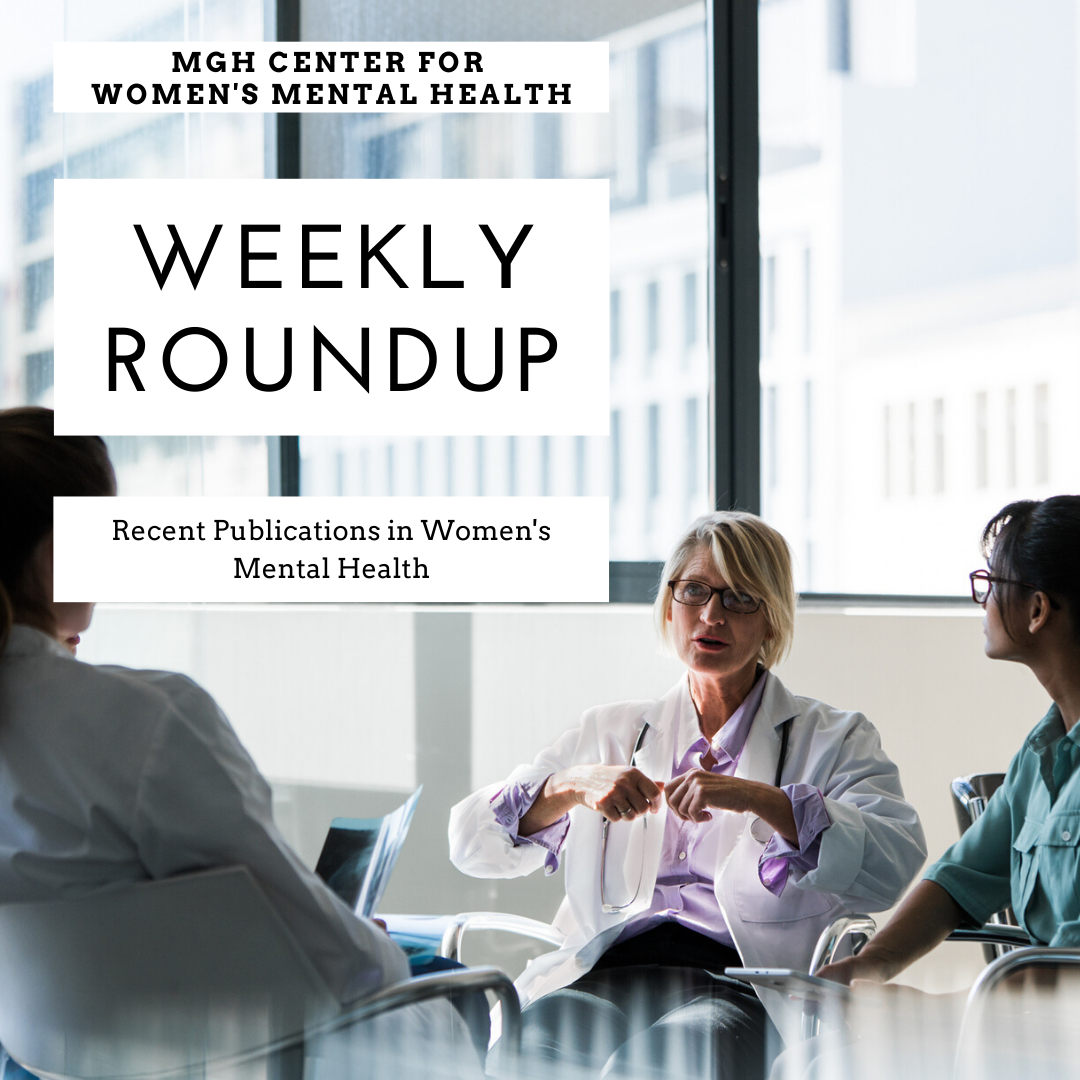
Every week we review the most recent publications in women’s mental health, covering topics related to premenstrual symptoms, perinatal mood and anxiety disorders, use of medications in pregnant and breastfeeding women, perinatal substance use, and menopausal mental health.
For more detailed descriptions of many of these topics, you can sign up to receive our weekly CWMH NEWSLETTER which comes out every Thursday.
And don’t forget to visit ESSENTIAL READS – a curated selection of up-to-date and clinically relevant articles in women’s mental health.
Ruta Nonacs, MD PhD
PMS AND PMDD |
| No articles this week |
INFERTILITY AND MENTAL HEALTH |
| No articles this week |
PSYCHIATRIC ILLNESS DURING PREGNANCY |
| The effectiveness of psychological interventions for anxiety in the perinatal period: A systematic review and meta-analysis.
Clinkscales N, Golds L, Berlouis K, MacBeth A. Psychol Psychother. 2022 Dec 11. doi: 10.1111/papt.12441. Review. In this review, psychological interventions were more effective than control conditions in reducing symptoms of perinatal anxiety (equivalent to a medium post treatment effect size). Effect sizes were robust for cognitive, behavioural and mindfulness-based interventions. Targeting anxiety also appeared to have an impact on depression symptoms. Ratanatharathorn A, Chibnik LB, Koenen KC, Weisskopf MG, Roberts AL. Sci Adv. 2022 Dec 14;8(50):eabn3740. |
MEDICATIONS AND PREGNANCY |
| Association of In Utero Antipsychotic Medication Exposure With Risk of Congenital Malformations in Nordic Countries and the US.
Huybrechts KF, Straub L, Karlsson P, Pazzagli L, Furu K, Gissler M, Hernandez-Diaz S, Nørgaard M, Zoega H, Bateman BT, Cesta CE, Cohen JM, Leinonen MK, Reutfors J, Selmer RM, Suarez EA, Ulrichsen SP, Kieler H. JAMA Psychiatry. 2022 Dec 7. In utero antipsychotic exposure generally was not meaningfully associated with an increased risk of malformations; however, larger studies are required to better estimate risks associated with exposures to atypical antipsychotics. Sundbakk LM, Gran JM, Wood ME, Handal M, Skurtveit S, Nordeng H. JAMA Netw Open. 2022 Dec 1; 5(12):e2246889. Free article. In total, 681 offspring (0.8%) in the full sample and 468 offspring (2.4%) in the mental health sample were prenatally exposed to benzodiazepines and/or z-hypnotics. After weighting, exposure in early (hazard ratio, 0.74; 95% CI, 0.39-1.94) and middle and/or late (hazard ratio, 0.76; 95% CI, 0.35-1.61) pregnancy was not associated with increased risk of childhood ADHD. There was no evidence of substantial association between the number of exposed intervals during pregnancy and childhood ADHD. |
| Risk of major malformations in infants after first-trimester exposure to benzodiazepines: Results from the Massachusetts General Hospital National Pregnancy Registry for Psychiatric Medications.
Szpunar MJ, Freeman MP, Kobylski LA, Caplin PS, Gaccione P, Viguera AC, Chitayat D, Hernández-Díaz S, Cohen LS. Depress Anxiety. 2022 Dec;39(12):751-759. There were 5 (3.21%) major malformations in the benzodiazepine exposure group and 32 (3.46%) in the comparison group (odds ratio 0.92; 95% confidence interval 0.35-2.41). |
POSTPARTUM PSYCHIATRIC ILLNESS |
| Family treatment for postpartum depression: acceptability, feasibility, and preliminary clinical outcomes.
Battle CL, Cardemil EV, Rossi R, O’Hara MW, Miller IW. Arch Womens Ment Health. 2022 Dec 6. Improvements in depression were observed among both mothers and fathers, and family functioning improved by the endpoint across several domains. Symptomatic and functional gains were sustained at follow-up. The current findings provide support for a larger randomized trial of family-based treatment for PPD. Wang W, Xu H, Ling B, Chen Q, Lv J, Yu W. Effects of esketamine on analgesia and postpartum depression after cesarean section: A randomized, double-blinded controlled trial. Medicine (Baltimore). 2022 Nov 25;101(47):e32010. Esketamine combined with sufentanil used for patient controlled intravenous analgesia after elective cesarean section improved postoperative analgesia, decreased postoperative nausea and vomiting, and decreased the incidence of PPD at 1 week and 6 weeks.
Brehaut E, Neupane D, Levis B, Wu Y, Sun Y, Ioannidis JPA, Markham S, Cuijpers P, Patten SB, Benedetti A, Thombs BD. Int J Methods Psychiatr Res. 2022 Dec 3:e1956. Optimal cutoff thresholds are selected to separate ‘positive’ from ‘negative’ screening results; however, how depression screening tool studies select optimal cutoffs is not consistent. Plieger T, Lepper J, Klein A, Reuter M. Psychoneuroendocrinology. 2022 Nov 30;148:105995. A negative subjective birth experience was associated with both PPD and maternal postpartum bonding problems. This study further shows a significant main effect of NR3C1 haplotype and a haplotype x birth experience interaction on PPD. The study did not find any NR3C1 haplotype effects on bonding. These results support the assumption that the glucocorticoid receptor coding NR3C1 gene is involved in the development of PPD. |
MEDICATIONS AND BREASTFEEDING |
| No articles this week |
PERINATAL SUBSTANCE USE |
| No articles this week |
MATERNAL MENTAL HEALTH AND CHILD OUTCOMES |
| Cite Share
Robakis TK, Roth MC, King LS, Humphreys KL, Ho M, Zhang X, Chen Y, Li T, Rasgon NL, Watson KT, Urban AE, Gotlib IH. Mol Psychiatry. 2022 Aug;27(8):3306-3315. doi: 10.1038/s41380-022-01592-w. Epub 2022 May 16. PMID: 35577912 Free PMC articl Zhang F, Zhou J, Zhang S, Qin X, Li P, Tao F, Huang K. J Affect Disord. 2022 Nov 28;323:176-184. Children of mothers with prenatal anxiety are at significantly elevated risk for abnormal mood/behavior at preschool age. Girls seemed to be more sensitive to maternal anxiety than boys, mainly manifested in internalizing problems. The third trimester of pregnancy might be a critical time window when maternal anxiety was associated with greater effects on children’s internalizing problems. Longer duration of maternal anxiety during pregnancy was associated with greater risk for internalizing and externalizing problems.
Groenewold NA, Wedderburn CJ, Pellowski JA, Fouché JP, Michalak L, Roos A, Woods RP, Narr KL, Zar HJ, Donald KA, Stein DJ. Neuroimage Clin. 2022;36:103206. Volumetric differences in subcortical regions can be detected in infants exposed to maternal depression in utero soon after birth, suggesting structural changes may occur in utero. Female infants might exhibit volumetric changes that are not observed in male infants. The potential mechanisms underlying these early volumetric differences, and their significance for long-term child mental health, require further investigation. |
MENOPAUSE AND MENTAL HEALTH |
| Menopause hormone therapy and complementary alternative medicine, quality of life, and racial/ethnic differences: the Study of Women’s Health Across the Nation (SWAN).
Christmas M, Janssen I, Joffe H, Upchurch D, Santoro N, Kravitz HM. Menopause. 2022 Dec 1;29(12):1357-1364. Overall, neither HT nor CAM was associated with improved QoL. Among White women, self-reported QoL was higher in HT-only users than in those who used neither. In contrast, Black women using HT only had lower self-reported QoL compared with Black women using neither. |
OTHER TOPICS IN WOMEN’S MENTAL HEALTH |
| No articles this week |



Leave A Comment